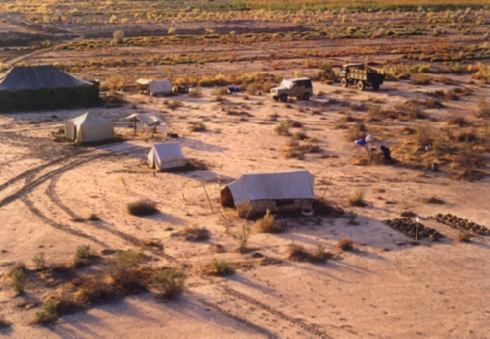Excavations at AK9 2003 - 2006
The present work, dealing with the citadel of AK9, renamed by the media the "Citadel of the Statuettes", will be presented in two volumes. One will be a general analysis of the excavations and the principal finds, and the other, currently in preparation, will deal with the apparatus needed to increase and compare our knowledge (laboratory analyses, catalogue of objects, anthropological remains, etc).
For the moment we will be careful to avoid new hypotheses or theories regarding either the Adji Kui complex or the prehistory of Margiana, since this field is already somewhat crowded. From 1949 onwards, when the first archaeological researches took place in Turkmenistan, there have been a flurry of elaborated theories and models which so für have not received any concrete confirmation and have left the field open to interminable discussions. Not even has computer science given us convincing solutions, also because these new methods lead one to construct grandiose projects while forgetting that, at bottom, all we have is a series of data gathered by man and, because of this, subject to error. Oversights, subjective interpretations, tiredness are constant traps and it is easy for a 'perfect" model to have very little to do with reality. In order to sort out this situation and provide specialists with proper documentation for the elaboration of acceptable hypotheses, only one possibility presents itself, the one that has always been with us: excavate and document as far as possible, provide certain and verifiable data.
Our mission has been working in Turkmenistan for 15 years and since September 2003 has been involved in the excavation of the citadel of AK9. If we translate that into figures, it means that our mission has been occupied in the excavation area for 12 months all told, with about 30 personnel including technicians and workers. They have dedicated 75,000 working hours to this project, living side by side in a camp which, however comfortable and organised it may be, is always in a precarious situation: sand storms, unnerving temperature ranges with sudden changes from torrid heat to below zero and continual problems with drinking water and a balanced diet. Added to this are troublesome and omnipresent neighbours who make an already complicated stay even more lively: wolves, hyenas, jackals, cobras, scorpions. Even a family of Persian lynxes (Caracal caracal michaelis Heptner), an endangered species, has chosen to make its home in the ruins of AK9.
It is obvious that, in these borderline conditions, it is not possible to carry out a textbook excavation. It is necessary to harmonise scientific necessities with objective reality and with the means, both technical and human, that we have at our disposal. It is not exactly easy. The most difficult problem we have had to deal with is the re-education of technicians and workforce regarding correct archaeological excavation procedure. These are people who already have long and solid experience, matured in other sites in Margiana where they had picked up the brusque habits of the old Soviet frontier school, which considered it superfluous to, for example, dig stratigraphic trenches, explore rubbish heaps and collect pottery that was considered "repetitive". Even the graves of infants that were found at the bottom of walls were removed immediately so as not to hold up the rhythm of excavation. At first, my colleagues could not understand why I wanted to rid them of these old habits, thus "delaying" their work and sweeping aside the remains of infants even before they had been properly identified. I thereföre decided to instruct Turkmen students and workers' foremen in a few theoretical-practical lessons, explaining to them the importance of every little trace discovered during the course of excavations and also the irreplaceable value of the context in which these finds had been made, as they alone made these mute objects speak. At the end, results were not slow in coming. The Ministry of Culture gratified me by awarding me the title of Honor Professor of the State Academy which, personally, I consider an important mark of recognition of the work carried out on behalf of future generations of Turkmen archaeologists and technicians.
I wish to reaffirm that whatever our mission has achieved has been possible thanks solely to the team spirit which has encouraged everyone: from the specialist to the technician, to the individual worker, to the director of the mission. Everyone dedicated himself to a single aim: to collect as many elements as possible in order to document the settlement of AK9. A role of simple "water carriers ".
Indeed, in our opinion, archaeological research in Margiana can only be carried out today by means of this type of work: excavate and document in order to understand. Only at the end, when the elements we have are more numerous and documented, can we put forward new theories and formulate new hypotheses. This is exactly what a great archaeologist of the East has recommended. Pierre Amiet, teacher and friend, recently quoted the words of the eminent French historian, Marc Bloch, in reference to this: "Understand! Do not make judgements... We will never understand too much".
(ibid., p. 15-19)
Source: Rossi Osmida, G.: Adji Kui Oasis.Vol.I: La Cittadella delle Statuette. Venice: Il Punto Edizioni 2007.

